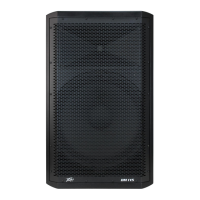power sources, use a dry cloth to remove soil or other dirt. Never use strong solvents on the DM™115, as they
could damage the cabinet. Do not allow ANY uids to drip inside the DM™115.
Touchup
For an overall nish enhancement and protective coating, use gloves to apply a plastic nish protector, such as
Armor-All® protectant or a similar product, to the surface of the plastic cabinet only. Note that the cabinet will be
slippery aer these treatments; rub them down vigorously with a dry, lint-free cloth to minimize this.
Check for Secure Hardware
Aer the rst few months of use and periodically thereaer, check the hardware of the DM™115 for tightness,
including the rear panel screws and the screws that hold the bae and rear cabinet together.
e unit is subject to a great deal of vibration, and this could cause them to loosen with use.
Architectural and Engineering Specications
e powered loudspeaker system shall have a frequency response from 62 Hz to 19 kHz. e peak SPL with
inaudible distortion shall reach 124 dB with music as a source, when measured at a distance of 1M and driven to
full output capacity. e system shall utilize a 15” heavy-duty woofer and a Peavey® DX™14 1.4” titanium dia-
phragm dynamic compression driver. e nominal radiation pattern shall be 110° in the horizontal plane, and
80° in the vertical plane. Axis of the vertical main polar lobe is angled down 10 degrees, resulting in the angular
pattern with respect to straight ahead being +30, -50 degrees.
e powered, bi-amplied loudspeaker system shall have an input channel consisting of a medium impedance
input connector consisting of one combo female XLR and 1/4” TRS phone jack on the rear panel.
ere shall be a ru (output) connector consisting of a male XLR jack.
e system power ampliers shall have an unltered frequency response of 20 Hz to 20 kHz which deviates no
more than +1, -3 dB up to rated power, hum and noise better than 90 dB below rated power, and THD and IMD
typically of less than 0.7%.
e woofer amplier shall be capable of 125W continuous into a 4 ohm nominal load, and the tweeter amplier
shall be capable of 80 W continuous output into a 8 ohm load, and both shall incorporate independent signal
compression.
e input signal shall be electronically divided into high frequencies and low frequencies by a Linkwitz-Riley
fourth order slope line-level crossover at 3.1 kHz. e low frequencies shall be processed to provide bass boost,
subsonic ltering and overall response shaping, and the high frequencies shall be equalized for response-shaping.
e enclosure shall be constructed of injection-molded polypropylene with a UL ame rating, and reinforcing
ribs internally. A handgrip shall be incorporated on each side near the woofer and towards the rear, and on the
top rear edge of the cabinet.
A full-length powder-coated metal grille shall be provided for horn and woofer protection. e cabinet shall
incorporate a pole mount for speaker stand use, four tall sturdy rubber feet for oor standing use.
e outside dimensions shall be: 25.30” (64.3 cm) tall x 14.38” (36.6 cm) wide x 14.00” (35.6 cm) deep, and the
weight shall be 35 lbs. Power requirements shall be: 170 Watts nominal, 120 VAC, 50/60 Hz Domestic and 220-
240 VAC, 50/60 Hz (Export). e loudspeaker system shall be called a Peavey® DM™115

